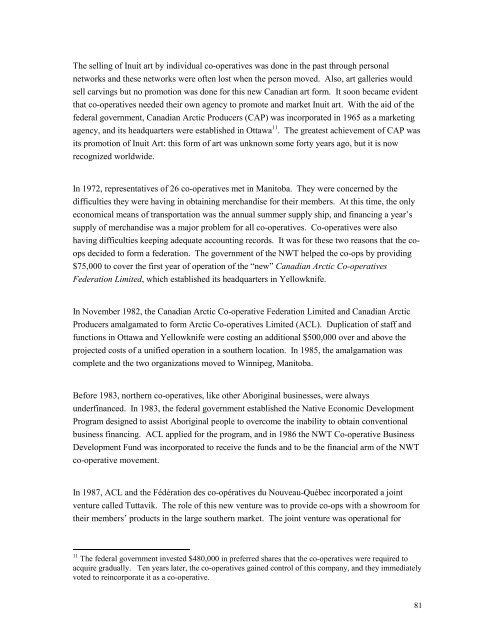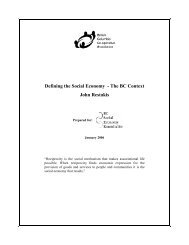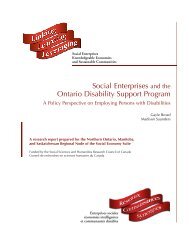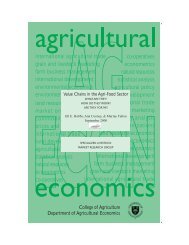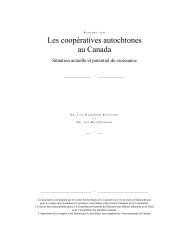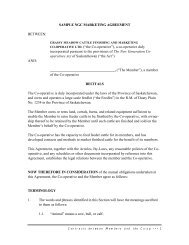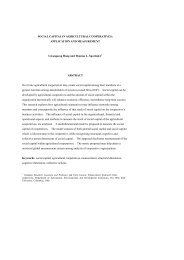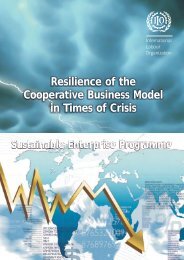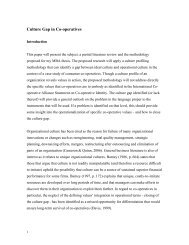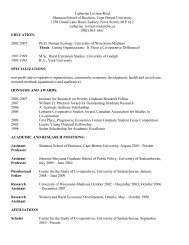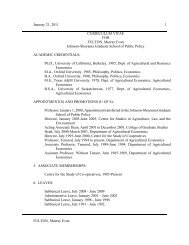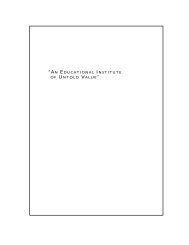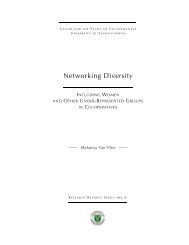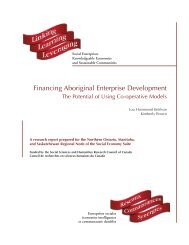Aboriginal Co-operatives in Canada - Centre for the Study of Co ...
Aboriginal Co-operatives in Canada - Centre for the Study of Co ...
Aboriginal Co-operatives in Canada - Centre for the Study of Co ...
You also want an ePaper? Increase the reach of your titles
YUMPU automatically turns print PDFs into web optimized ePapers that Google loves.
The sell<strong>in</strong>g <strong>of</strong> Inuit art by <strong>in</strong>dividual co-<strong>operatives</strong> was done <strong>in</strong> <strong>the</strong> past through personalnetworks and <strong>the</strong>se networks were <strong>of</strong>ten lost when <strong>the</strong> person moved. Also, art galleries wouldsell carv<strong>in</strong>gs but no promotion was done <strong>for</strong> this new Canadian art <strong>for</strong>m. It soon became evidentthat co-<strong>operatives</strong> needed <strong>the</strong>ir own agency to promote and market Inuit art. With <strong>the</strong> aid <strong>of</strong> <strong>the</strong>federal government, Canadian Arctic Producers (CAP) was <strong>in</strong>corporated <strong>in</strong> 1965 as a market<strong>in</strong>gagency, and its headquarters were established <strong>in</strong> Ottawa 11 . The greatest achievement <strong>of</strong> CAP wasits promotion <strong>of</strong> Inuit Art: this <strong>for</strong>m <strong>of</strong> art was unknown some <strong>for</strong>ty years ago, but it is nowrecognized worldwide.In 1972, representatives <strong>of</strong> 26 co-<strong>operatives</strong> met <strong>in</strong> Manitoba. They were concerned by <strong>the</strong>difficulties <strong>the</strong>y were hav<strong>in</strong>g <strong>in</strong> obta<strong>in</strong><strong>in</strong>g merchandise <strong>for</strong> <strong>the</strong>ir members. At this time, <strong>the</strong> onlyeconomical means <strong>of</strong> transportation was <strong>the</strong> annual summer supply ship, and f<strong>in</strong>anc<strong>in</strong>g a year’ssupply <strong>of</strong> merchandise was a major problem <strong>for</strong> all co-<strong>operatives</strong>. <strong>Co</strong>-<strong>operatives</strong> were alsohav<strong>in</strong>g difficulties keep<strong>in</strong>g adequate account<strong>in</strong>g records. It was <strong>for</strong> <strong>the</strong>se two reasons that <strong>the</strong> coopsdecided to <strong>for</strong>m a federation. The government <strong>of</strong> <strong>the</strong> NWT helped <strong>the</strong> co-ops by provid<strong>in</strong>g$75,000 to cover <strong>the</strong> first year <strong>of</strong> operation <strong>of</strong> <strong>the</strong> “new” Canadian Arctic <strong>Co</strong>-<strong>operatives</strong>Federation Limited, which established its headquarters <strong>in</strong> Yellowknife.In November 1982, <strong>the</strong> Canadian Arctic <strong>Co</strong>-operative Federation Limited and Canadian ArcticProducers amalgamated to <strong>for</strong>m Arctic <strong>Co</strong>-<strong>operatives</strong> Limited (ACL). Duplication <strong>of</strong> staff andfunctions <strong>in</strong> Ottawa and Yellowknife were cost<strong>in</strong>g an additional $500,000 over and above <strong>the</strong>projected costs <strong>of</strong> a unified operation <strong>in</strong> a sou<strong>the</strong>rn location. In 1985, <strong>the</strong> amalgamation wascomplete and <strong>the</strong> two organizations moved to W<strong>in</strong>nipeg, Manitoba.Be<strong>for</strong>e 1983, nor<strong>the</strong>rn co-<strong>operatives</strong>, like o<strong>the</strong>r <strong>Aborig<strong>in</strong>al</strong> bus<strong>in</strong>esses, were alwaysunderf<strong>in</strong>anced. In 1983, <strong>the</strong> federal government established <strong>the</strong> Native Economic DevelopmentProgram designed to assist <strong>Aborig<strong>in</strong>al</strong> people to overcome <strong>the</strong> <strong>in</strong>ability to obta<strong>in</strong> conventionalbus<strong>in</strong>ess f<strong>in</strong>anc<strong>in</strong>g. ACL applied <strong>for</strong> <strong>the</strong> program, and <strong>in</strong> 1986 <strong>the</strong> NWT <strong>Co</strong>-operative Bus<strong>in</strong>essDevelopment Fund was <strong>in</strong>corporated to receive <strong>the</strong> funds and to be <strong>the</strong> f<strong>in</strong>ancial arm <strong>of</strong> <strong>the</strong> NWTco-operative movement.In 1987, ACL and <strong>the</strong> Fédération des co-opératives du Nouveau-Québec <strong>in</strong>corporated a jo<strong>in</strong>tventure called Tuttavik. The role <strong>of</strong> this new venture was to provide co-ops with a showroom <strong>for</strong><strong>the</strong>ir members’ products <strong>in</strong> <strong>the</strong> large sou<strong>the</strong>rn market. The jo<strong>in</strong>t venture was operational <strong>for</strong>11 The federal government <strong>in</strong>vested $480,000 <strong>in</strong> preferred shares that <strong>the</strong> co-<strong>operatives</strong> were required toacquire gradually. Ten years later, <strong>the</strong> co-<strong>operatives</strong> ga<strong>in</strong>ed control <strong>of</strong> this company, and <strong>the</strong>y immediatelyvoted to re<strong>in</strong>corporate it as a co-operative.81


